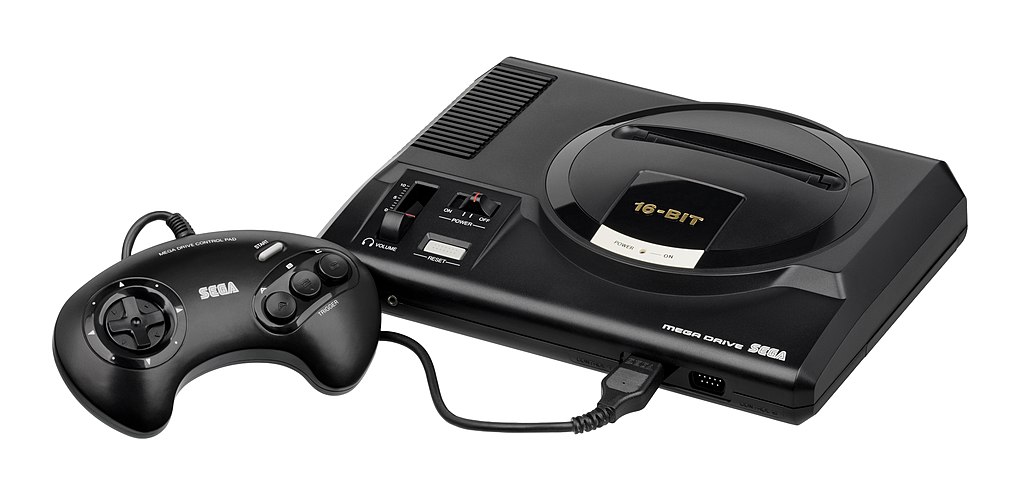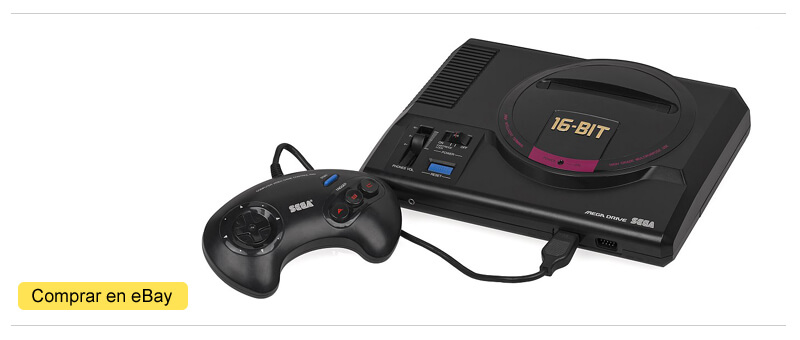The SEGA Mega Drive, most beloved console, the 16-bit video game console that brought all the magic of arcades to our homes is, without a doubt, one of the most important machines in the history of video games. A console capable of consolidating the SEGA brand outside its borders and facing the almighty Nintendo.
In this article we will review the entire history of the SEGA Mega Drive / SEGA Genesis, its background, its beginnings, prices, best games, anecdotes and curiosities, all this, from the usual Infoconsolas point of view: From collectors for collectors, from lovers of the retro for video game lovers. Come in and let’s remember one of the best consoles of all time! The console that waged the great Console War in the 16-bit battle.
| COMPANY: | SEGA |
| CONSOLE GENERATION: | FOURTH GENERATION |
| RELEASE DATE: | October 29, 1988 in Japan August 14, 1989 in North America September 1, 1990 in Europe |
| GAMES CATALOG: | 878 cartridges |
| SOLD UNITS: | 30 million units approx. all over the world |
| LAUNCH PRICE: | 21.000 yenes |
| PROCESSOR: | Motorola 68,000 16-bit at 7.61 MHz (PAL) or 7.67 MHz (NTSC) |
| FORMAT: | Cartridge + CD-ROM (SEGA CD) |
| BUY IT ON EBAY: | https://ebay.us/VttaIX |
- History of the Mega Drive
- Price of a Mega Drive console, how much did it cost?
- The price of video games on the Mega Drive. How much did a cartridge cost?
- Collecting the Sega Mega Drive
- Buy a Sega Mega Drive
- TOP Retro: Best Sega Mega Drive Games
- Technical characteristics of the Mega Drive
- FAQ MegaDrive
Mega Drive / Genesis, the 16 bits of Sega
The Mega Drive or Sega Genesis (America) represents one of the most beautiful eras of video games. A few years in which the future of the industry was yet to be decided, home video games were experiencing a new golden age (replacing that of microcomputers and arcades), video game consoles were real consoles and not simple computers with controllers (or controllers connected to the cloud), when the different brands still had different architectures, a time when users were able to appreciate for ourselves the technical differences between one console and another, to compare the different versions of the same video game or to enjoy the exclusivities of one or another console, we are talking, after all, of the 16-bit era and one of its greatest representatives, the Sega Mega Drive.
Without a doubt, the 16-bit years are one of the best years in the history of video games, a sweet period in which most of the franchises that we still play were created or consolidated, years of fierce competition and great games, video games that we could mostly enjoy on the Sega Mega Drive. Owning this console at the time of its launch meant being able to enjoy a selection of video games comparable to the best arcade games of its time, to understand us: speaking at the school level (EGB), let’s say that you automatically became the leader of the entire playground, there were no very correct politicians in those years, you had a Mega Drive and the rest of mortal inferiors, spent hours with an NES, Master System, Spectrum (Great!) or Commodore. You were the fucking master and every god wanted to come to your house on Friday afternoon. No girls (let’s not freak out), but all the guys did want to come to your house.
The predecessors of the Mega Drive
Like all consoles, the Mega Drive did not come out of nowhere, belonging to the deified one, due to the aggrandizing effect of nostalgia and its own merits, SEGA, the 16-bit console from the blue hedgehog company, already had the ground well fertilized by those years:
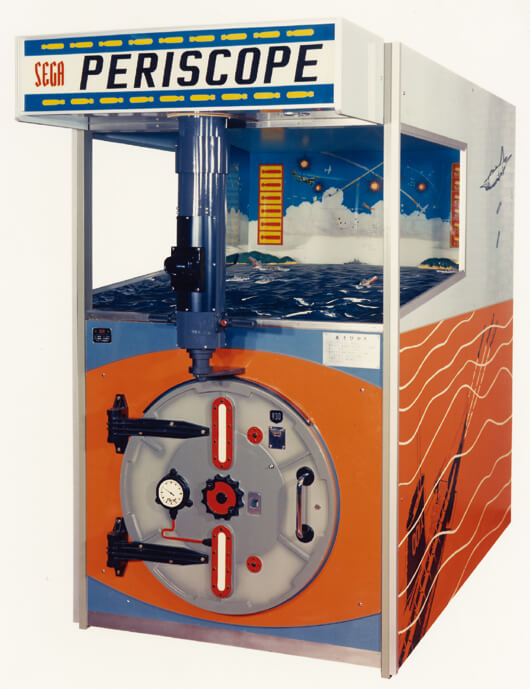
Since the 1960s, Sega had been manufacturing electromechanical machines with notable success, such as Periscope (1966), Grand Prix (1969), Night Rider (1970) or Duck Hunt (1968). After the video game boom at the beginning of the 70’s, thanks to the technological advances that were taking place, Sega began to produce recreational machines in a few years in which arcade machines were the true queens of video games. In this way, during the 70’s and early 80’s Sega became one of the leading arcade companies in Japan and the United States, characterized by launching video games in many architectures (systems) and consequently, different technologies: Blockade, VIC Dual, G80, VCO Object or LaserDisc, are some of the different boards on which they launched a multitude of games.

The 70’s were years in which the advances were happening for months, and the players migrated from one game to another every few weeks, witnessing the new advances that the arcade companies offered every little time. Obviously, the wear and investment in research and development was enormous, launching better games meant improving the technical characteristics of the arcade hardware, with all the problems that this entailed. This problem led companies to change their business model, going from having arcades dedicated to a single title (Pong, Space War…), to taking advantage of the same arcade system for different titles, thus making the investment and resources profitable. dedicated to hardware development. It is at this time that the Sega System 1 system appears in 1983 based on the Z80. The Sega System 1 became a benchmark with games like Choplifter, Sega Ninja or Wonder Boy. As a result of System 1, System 2 emerged a few years later, an improved arcade board based on System 1 with which it shared a CPU and later Sega launched System 16 in 1985, an arcade system that made the leap to 16 bits and became the queen of arcades with video games like Shinobi, Fantasy Zone, Altered Beast and Golden Axe. The System 16 had a Motorola 68000 CPU accompanied by a Zilog Z80 support, an architecture that was later imitated by various systems.
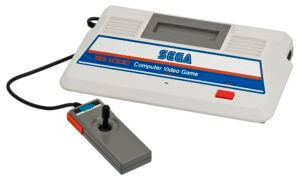
At the same time, in the world of consoles, Sega ventured into the domestic market with the SG-1000 console in 1983, an 8-bit console and third generation of video consoles that was not up to its competitors, it was updated in 1984 launching like the SG-1000 II, the same console but with a redesign that allowed it to connect to a keyboard and other peripherals, and not to mention, in 1985 Sega released the Sega Mark III, the console that was later distributed for the first time internationally by Sega, which we all know as Master System (1986). They were years of continuous evolution in which the video game market was not yet defined as such, so there was no single path to success.
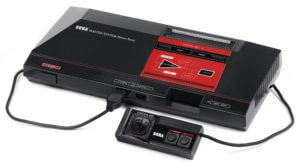
And it is at this moment where the lines of arcade and home consoles converge at the same point. With a Japanese and North American market taken over by Nintendo’s NES, the Master System had only managed to obtain good results in Europe and some countries such as Brazil. Sega dominated the arcades with a string of hits but failed to penetrate homes. To make matters worse, the almighty NES was joined in 1987 by the technically superior PC Engine, an 8-bit console with 16-bit graphics processors. Sega was clear that to conquer the home market they would have to launch a 16-bit console, so they commissioned their successful System 16 board to be adapted to a home system.
In October 1988, the new 16-bit console was launched in Japan, its name, Sega Mega Drive. The Mega Drive emerged as a console based on SEGA’s arcade games, designed by the same team of people who developed SEGA’s arcade games… It’s not just that the Mega Drive was a “domesticated” arcade game, with all the potential it that means, is that the Sega console was made by the leading and most successful arcade team of those years, quite a blow and a guarantee that their console should be taken very seriously, SEGA had put all the meat on the grill with it.
The launch of the original Mega Drive
Far from what it may seem, the launch of the Sega Mega Drive had a very uneven reception among the public of the different markets, being highly influenced by the maneuvers of the competition and the context of the receiving markets:
JAPAN: The release of the Mega Drive on October 29, 1988, was completely overshadowed by the Famicom (NES) video game Super Mario Bros 3, released on October 23, 1988 (5 days earlier) than the SEGA video game consoles. This great game from Nintendo with support chips in the cartridge itself was Nintendo’s way of showing its public that they did not need to migrate to new systems: Nintendo could improve the quality of its games through the cartridges themselves until the arrival from the SNES. On the other hand, the SMB 3 was practically a must buy for active Famicom players, a masterpiece of the well-known Mario. Added to the hype generated by the announcement of a “next” new Nintendo console, the Mega Drive was relegated in sales to third place in the Japanese market, behind the NES and NEC’s PC Engine, which had a price of its video games much cheaper thanks to its card format instead of cartridge.
The SMB 3 move came out round for Nintendo, since it was a way to stop the first purchase impulse of many users, making them spend a considerable sum of money a week before the launch of the SEGA console, in a few years in which that the audience for video games was mainly children and adolescents with little purchasing power and ability to save. Buying a new cartridge from the Famicom could delay the purchase of a new console for months, giving Nintendo and its communication department time to convince/influence their public to wait for their next 16-bit console.
UNITED STATES: The Mega Drive was renamed the Sega Genesis and released on August 14, 1989. Previously, the Master System had already been released and despite being technically superior to the NES, Nintendo’s 8-bit also dominated the market for video games to the detriment of MS. On this occasion Sega directly assumed the distribution of the console (Atari also rejected them), but its launch was staggered, starting with two large cities and later moving to the rest of the country, a factor that did not help sales and marketing at all. Still, being released a year after Japan, the Genesis presented the US market with a terrific catalog of games in its first year, which alone increased its sales: Altered Beast, Space Harrier II, Thunder Force II, Super Hang-On, Ghouls ‘n Ghosts, The Revenge of Shinobi, and Golden Ax were true console sellers.
EUROPE: The Mega Drive kept its original name and was released in September 1990. The story was quite different from Japan and North America. In Europe, the Master System had been well received by the general public, so the jump to Sega’s 16-bit was much easier. In Europe at that time there was a great fashion with micro computers such as Amstrad, Commodore and Spectrum, the comparisons between these and the 8-bit consoles were already hateful, but since the cartridges are a much more expensive format, the micro computers still defended themselves… With the arrival of the Mega Drive there was no longer anything to discuss, the Mega Drive far exceeded anything seen and the Sega console and its 16-bit power were a success on the continent.
Even so, Europe in those years was not as heterogeneous a continent as it is today, the borders between countries remained standing as well as their customs, different currencies, great cultural differences and various trade treaties with other powers in each country. Unlike today, where we have a globalized world and considerable European sentiment, Germany, France and Spain had little in common socially and culturally, so SEGA’s penetration in the different specific markets differs greatly between them.
The Great Battle: The 16-Bit War
The 16-bit War is one of the most exciting times in the history of consoles from the point of view of a user, the kids who at that time were going to make the leap to 16 bits, had the great responsibility of choosing correctly, that this would be the system that we would maintain for many years, at a time when years and time are mediated in school courses and these became eternal… And not only that, once the new system was adopted, we should defend it to the death against our adversaries, no matter what happens, whatever game is launched, whatever megabytes or colors it may be, we should always have enough arguments to launch a good attack or a good counter. The world was divided into two parts: SEGA and NINTENDO.
And from here is when all of us who take to writing and sharing our experiences, we get even more melancholic and nostalgic and we start to remember the “War of the consoles” from our particular point of view… But no it’s so simple, the war between SEGA and Nintendo for 16 bits was very different depending on the battlefield:
JAPAN: In the land of the rising sun, the war between the two companies was non-existent in the domestic market, Nintendo had taken over 92% of homes with the NES, had resisted the strong attack of the PC Engine and as we have already mentioned, For the launch of the MegaDrive, he had reserved the premiere of Super Mario Bros 3, a supervitaminated cartridge that minimized the advantages of the Sega console over Nintendo’s 8-bit console. With the Famicom, its franchises and the hype of the future release of the Super Famicom, Nintendo endured 2 years and a month until the arrival of “the brain of the beast”, at which point the MegaDrive was definitively humiliated and relegated to a third put behind the PC Engine. In Japan there was never any war for 16 bits, the technical superiority of the Super Famicom and the fidelity of the Japanese for the Mario brand, made it impossible for Sega, -a well-known brand in arcades-, to penetrate the domestic market. .. That was the reality of the MegaDrive in Japan, a console that, no matter how many add-ons they launched, barely reached 10% of the market.
But fortunately for Sega, the blue hedgehog company since its inception has been a company founded by the merger of North American and Japanese companies, a long history that in practice, far from what most people think, makes Sega a company with a much more global vision than the rest of its Japanese competitors, giving more importance to internationalization and having a deeper knowledge of the American market than its rivals. Sega was the company best prepared to compete with Nintendo outside of Japan, since it was also a North American company, and it was.
NORTH AMERICA: Nintendo’s NES had relaunched video games and had become the undisputed leader in the sector, with a “justified” monopolistic attitude to avoid another crisis, prioritizing the quality of its licensed video games above all else, reaching a point where could be considered superb. Nintendo had defeated all its rivals including North American companies such as Coleco, Mattle, Atari or Sega itself with its Master System, a console with better technical characteristics than the NES, but not enough to relegate it, no one who had a NES would give the jump to the Master System, there was no reason. Nintendo had the best licenses, exclusivities, contracts with retailers and was already part of American society and culture. He was a true GIANT.
Given this situation, Sega began a first year with a mediocre and scaled launch of a pack of its Mega Drive with the video game Altered Beast for 189 dollars (1989), despite having better quality and features than the NES, Sega did not arrive to sell not even a million units which was a great disappointment for the directors of Sega Japan, which caused a change in the American directive and a shift in the strategy to be followed by the company, the frontal attack against Nintendo began:
- The price of the console would be lowered following Gillette’s strategy: Cheap consoles, expensive replacements (cartridges). The Mega Drive dropped to $149 and the intention was to continue lowering the price.
- They needed a mascot like Mario, with personality and to represent the brand. The search began and once chosen, the video game that would accompany the console began to be programmed: Sonic The Hedgehog, more energetic, faster and easier to handle than Mario. The best game of the brand would accompany the console assuming the lost income as a long-term investment.
- Japan was and is a very different market from the West, Sega America was aware and consequently a development team specialized in North American tastes would be created. On the other hand, as Nintendo had the main licenses and exclusivities, Sega strengthened its contacts with computer developers and contracts with athletes and celebrities, with sports simulators being a perfect genre for the potential of its machine.
- Much more aggressive advertising campaigns. Sega went toe to toe with Nintendo and showed everything that the NES could not do, as well as the superiority of its 16 bits. Subsequently, Sega would seek to attract a more adult audience (and with more purchasing power) thanks to its more mature games and without as many restrictions as those of Nintendo.
The execution of these 4 pillars, ensured that, from being a residual domestic system brand from Nintendo’s point of view, Sega was gaining ground, getting many of the players who were waiting for the Snes to give up and acquire a Mega Drive. The launch of Sonic the Hedehog in July 1991, was the spark that many users were waiting for to decide, Sonic was up there with Mario and if they wanted to play it, they could only do it on a Sega console.
When Nintendo launched its Super Nintendo in the United States in August 1991, with a dozen games and its Super Mario World for $199, Sega had already established itself in the market with a 16-bit video game console, a reference mascot with a great game, a price less than 199 dollars and a catalog of more than 150 video games available…BOOM! Finally, after many years, Nintendo found a worthy rival to beat.
The Super Nintendo appeared as a superconsole with its own architecture that, in performance, theoretically surpassed the MegaDrive. In contrast, the Sega Mega Drive with an older architecture, took advantage of the raw power of its CPU, which surpassed the Snes CPU. This was one of the main arguments that saved the MegaDrive in those endless school debates… but as we have said, Sega already had at the launch of the Snes a large number of consoles in homes and a large catalog, in addition of a good mascot and specific video games aimed at a more adult audience than that of Snes. With this context, a great battle of millions of units sold and percentages began.
Year after year, the Snes got closer to the total numbers of the Mega Drive, both companies offered their best video games on their consoles: Sonic and Mario World, Final Fight and Street of Rage, Street Fighter II and Eternal Champions, different Dragon Ball Z, Stunt Race FX and Virtual Racing… The Snes and Mega Drive experienced one of the biggest commercial wars in the history of consoles, with each great game of one, another great title came out of the other. With regular price drops for both consoles, but the Mega Drive is always the cheapest option. The fight was fierce, but little by little it looked like the Snes, it was gaining ground thanks to its technical superiority. Given this, Sega decided to improve their console with different peripherals that we will see later, but their high price and little support led them to failure, especially when users saw that the Snes option to improve their games by adding chips and memory to their cartridges (ex: Donkey Kong Country), gave good results, giving the feeling that it was the console itself that did all the work.
Sega and Nintendo were very evenly matched in the 16-bit era in the United States, but eventually the Snes surpassed the number of units sold. Is this fact significant? No, not really, the Mega Drive proved to be a great console to rise to the occasion, putting Nintendo in its place and taking away much of the market that the NES had conquered.
EUROPE: The European territory was similar to the United States, but with a clear difference, in Europe Sega won.
In Europe, the Master System had been a great success, so much so that in its different versions it surpassed Nintendo’s official NES, selling Sega 7 million consoles compared to 6 million Nintendo units. Surely, if we could add to the figures of the NES all the clones like NASA that swarmed Europe in those years without any problem, the NES would clearly surpass the Master System, but either way, the point is that Sega conquered Europe with its 8 bits, along with Nintendo.
To this fact, we must add that the Mega Drive was launched in Europe in September 1990, already having an immense repertoire of good games, which was expanded until the late launch of the Snes in June 1992. These years of difference gave the Mega Drive a great advantage over its rival. If someone thinks that it was easy to endure 2 school years (with “good grades”), 2 birthdays, 2 Three Kings, 2 Santa Claus and a possible communion through the medium plus their own piggy bank/savings without asking for or acquiring a new console… .the numbers tell us that it is not. The Mega Drive started with a great advantage over the Snes, at a time when due to the purchasing power of young video game users, if you had a 16-bit, you couldn’t buy another 16-bit… period.
Even so, Sega did not take full advantage of its advantage, opting for a somewhat unusual strategy until the arrival of the Snes: It promoted both its 8 bits and its 16 bits in the same way, with a redesign of the Master System becoming the Master System II, which was a great success. It is true that thinking of the youngest, it made sense to offer a cheaper 8-bit product, hoping to win their loyalty so that later they would make the leap to 16-bit, but in Europe, unlike Japan, who acquired a console in 1990 or 1991 , I didn’t change it the following year for a better one, here we put up with the systems we acquired for more years until “amortizing” them, so in practice, many of those who bought a Master System II in 1990, 1991 or 1992 later gave the jump to the Snes, to be able to verify as the Nintendo, was a technically superior console to the Mega Drive. Mega Drive tried unsuccessfully to override this dynamic by removing an adapter to be able to play Master System games on the Mega Drive, but unlike Japan, we Europeans don’t sell our systems for new ones, we keep them as our homes are larger and we don’t have the space problem of the Japanese.
Due to Sega’s strategy of promoting both its 8 and 16 bits, the SNES sold many more consoles in Europe than it initially would have if Sega had been exclusively dedicated to its Mega Drive, but even so, Europe was always from SEGA. Nintendo made it very difficult for it, it showed its shortcomings and gradually gained ground, but it never caught up with it. The Mega Drive sold 9.2 million consoles in Europe, the Super Nintendo (without any clone), 7.7 million consoles. Big numbers for both consoles, but a clear win for Sega’s Mega Drive. Europe became the great bastion of Sega.
To get an idea of how late the launch of the Super Nintendo was in Europe (1992), a console launched in Japan in 1990, taking into account that the Mega Drive was already present in Europe in that same year (1990), think that the PlayStation and Saturn arrived in Europe in 1995, that is, only 3 years after the launch of the Snes we were already “freaking out” with the arrival of the true 32 bits and their 3D.
For Europeans, the real technological leap was the Mega Drive and later the 32-bit, the Snes was a great console that we were able to enjoy in the midst of this transition, but there was no wow factor like we have enjoyed in generational leaps. Sega did a great job successfully adapting the strategy followed in the United States: Price, Sonic, aggressive marketing and Westernized games. Even so, in its last years before the adaptation by a large part of the 32-bit public, with the intention of surpassing the Snes, SEGA made a series of mistakes based on the launch of expensive peripherals that we will see below, which would seriously damage your image and the trust of your followers.
But high! We cannot finish a section as big as the console war in the 16-bit era, without mentioning the rest of the contenders. It is true that the Mega Drive and the Snes were the consoles that had the most prominence, theirs was the war, but there were many more consoles that tried to steal the leadership of Sega and Nintendo… And some of them succeeded. Setting the deadline for the year 1994, in which the Play Station would be launched (to which the 16 bits would endure commercially for many years), here are the other consoles that shared time and space with the Mega Drive and Snes, their other competitors .
The other competitors of the MegaDrive / Genesis
PC Engine / TurboGrafx, 1987 / 1989.
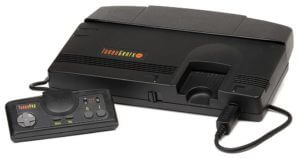
It was one of his great rivals in Japan and the United States. In Japan, the PC Engine was second behind the Snes, which means that commercially it surpassed the SEGA console. In North America the Mega Drive far surpassed it and in Europe its role was purely residual. Magnificent console that, if it had exported the localized but magnificent catalog of the PC Engine, would have been much more successful than its western version. We recommend his dedicated article since his business strategy in Japan has been unique in the history of video games.
Super Grafx, 1989.
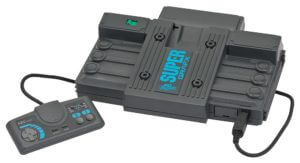
A beast only comparable to the Neo Geo AES, but much more exclusive. Its high price took it out of any war, the Super Grafx is possibly the most sought after console by expert video game console collectors, a machine that despite its commercial failure, has gone down in history as one of the best consoles of its kind. weather. Obviously, exclusive to Japan (and surprisingly France, due to its centuries-old commercial contacts with Kyoto).
NEO GEO AES, 1990.

The Neo Geo has always played in another league, so while the Snes and the Mega Drive were fighting in the schoolyard, the Neo Geo was watching them from the principal’s office. The SNK console was at another level, no one doubts its superiority, although in terms of sales the SEGA and Nintendo consoles were far above it. Also very interesting is its business model based on the parallelism of arcade and home console, optimizing resources and lowering development costs.
Commodore CDTV, 1991.
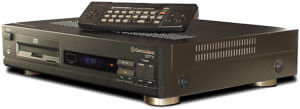
We entered the field of multimedia, a cursed word at the beginning of the 90’s. Being a console convertible into a computer, Commodore (a brand that was already in the doldrums), ventured in its own way into the world of consoles with a monumental failure based on its Amiga 500 that cost a fortune. The console went completely unnoticed and could do nothing against the Japanese 16 bits.
Philips CD-i, 1991.
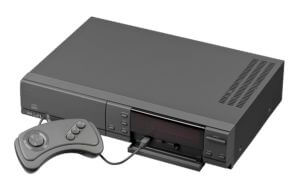
Emphasizing and enhancing its interactive, multimedia and educational side, Philips stuck to it regardless of its CD or deals with Nintendo. The Mega Drive didn’t even tickle it. The concept of CD-I was really interesting, but its playability was laughable compared to the SEGA and Nintendo consoles.
FM Towns Marty, 1993
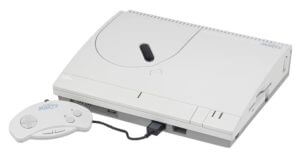
Big words: 32 bits, CD, operating system with its own graphical interface, compatible with FM Towns computers (with certain bugs)… The FM Towns Marty is a super console that was released only in Japan, its price and the fact that that the competition in the computer sector had better positioning, meant that the console did not affect the evolution of the Sega and Nintendo consoles.
Atari Jaguar, 1993
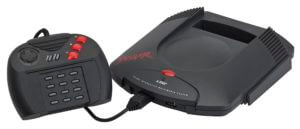
Ahead of its time, the Atari Jaguar innovated with its 64 bits, but its architecture was too complicated and limited for developers. It turned out to be a transition console from 16 to 32 bits. The 16 bits withstood the pulse with the launches of its best games and won the commercial battle. Atari’s last flick was disappointing.
3DO, 1993
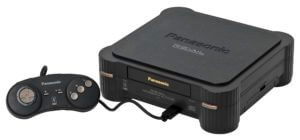
Panasonic’s 3DO came close to what 32-bit should be, but it didn’t. Its price and a catalog that could not cope with that of the Mega Drive or Snes, made this console standard distributed by various brands not enough and we waited for the proposals from Sega and Nintendo, although later it was Sony that take everything It really was a system that pleasantly surprised us all, but it had the misfortune of being released just before the technological advances and cheapening of polygon-focused processors, so despite its remarkable performance, nothing could stand up to the consoles that were to come. The comparative tables of specialized magazines and the millions of polygons per second sentenced the 3DO.
Amiga CD32 , 1993
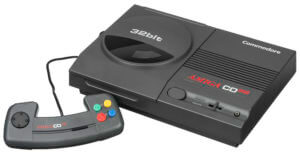
After the CDTV, the guys at Commodore still wanted more, launching their “advanced” Amiga CD 32, an Amiga 1200 without access to licenses that was successful on consoles and, with hardware superior to 16-bit, but not enough to show a technological leap corresponding to a change of generation. Its bad press and terrible distribution did the rest, it was an absolute failure.
Pioneer LaserActive, 1993
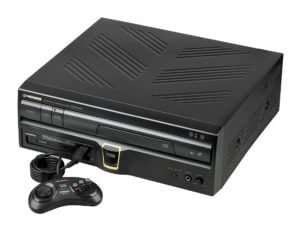
A hybrid between the Laserdisc and a console launched in Japan and the United States, which took the word “multimedia” to another level: video, music, karaoke, videogames… The possibility of acquiring two modules for a fortune to be able to play PC Engine and Megadrive games, plus 3D glasses, predicted a tremendous hit… And so it was.
The different versions of the Sega Mega Drive and its peripherals
Already in full advertising campaign before the launch of the Mega Drive, Sega presented a whole set of future peripherals that would take its 16-bit console to another level, matching the 16-bit computers of the time. Initially, the console was considered as a base on which multiple tasks and functions could be carried out based on extensions.
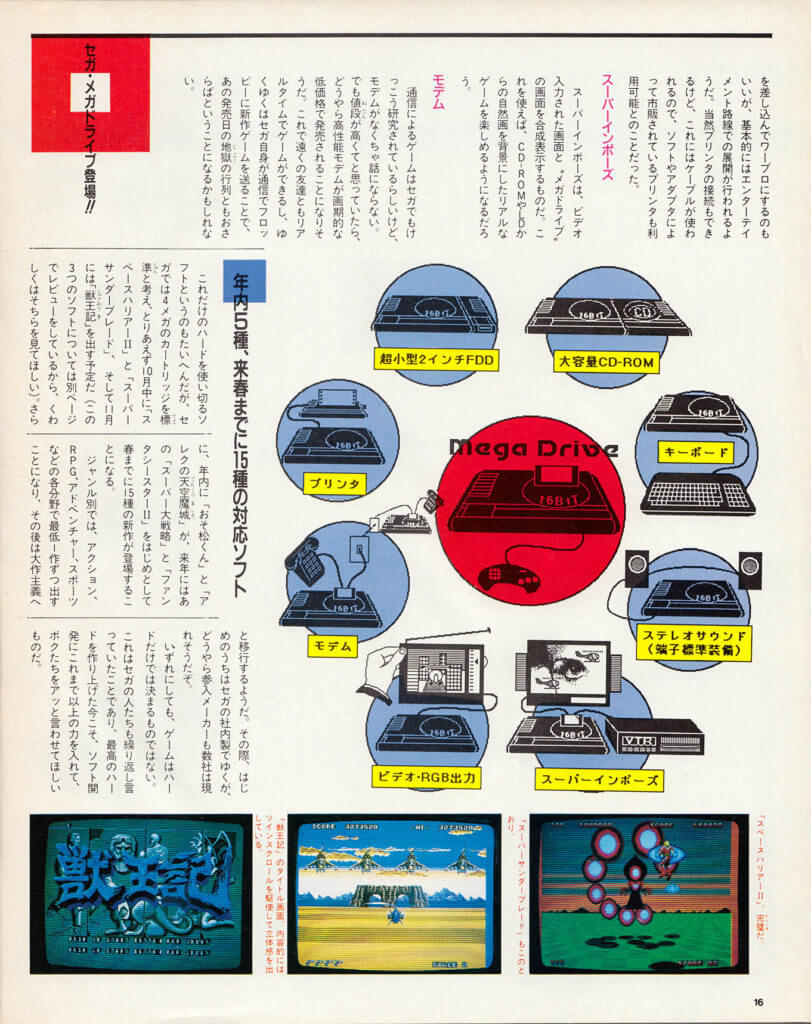
And what if they did, the disadvantaged situation in the Japanese market due to various factors such as the technical superiority of the Super Nintendo and its large number of faithful, forced Sega to follow an even more aggressive strategy. Sega could not focus solely on its video games as they did in Nintendo, to counteract the monopolized Japanese market by the plumber’s company, Sega made an effort to offer a specific product to different types of audiences and needs, anticipating many of its rivals and turning its Mega Drive, on a base on which its own universe of consoles and peripherals was created:
Power Base Converter
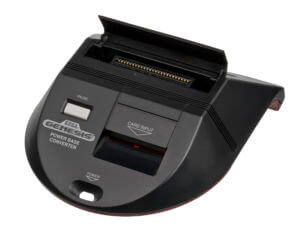
An adapter to be able to play the cartridges and cards of the Master System. It was a way of retaining its users: Don’t worry young man, you can change consoles, your games will continue to work on the Mega Drive, Sega won’t let you down. In Japan, a peripheral like this made a lot of sense, since due to lack of space it is very common to sell the consoles to renew them for a superior one that occupies that precious space next to the television, but in the rest of the world it was one more peripheral that We didn’t see much point in it.
Sega Modem
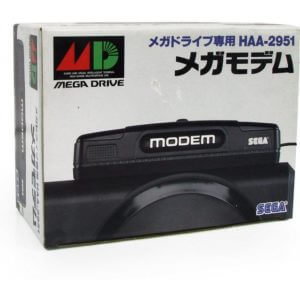
Exclusive to Japan, it was a preview of what was to come years later. Focused on an adult audience, you could carry out bank transactions as well as connect to the MegaNet under subscription and download small games (special cartridge necessary) or play the games that included online. That said, quite an advance that, far from contributing to the commercial success of the console, improved the image of SEGA as a leading technology company on a par with that of its console. One more option to tip the balance in your favor at the time of purchase decision.
Sega Channel
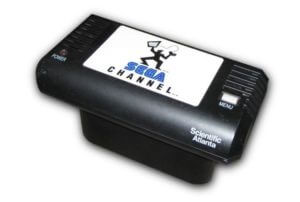
Peripheral with 4 megabytes of memory that allowed you to connect, for a monthly subscription, to the cable television channel, Sega Channel, where you could download different games among other services. Much better than paying the gym fee. And now… let’s think about it: With the Sega Channel we are talking about a peripheral from 1994 that was almost 15 years ahead of streaming services and game downloads like the current ones (Game Pass), a real barbarity that used the technological possibilities of his time to offer us endless hours of vice, at a flat rate… Crazy!
It is true that in South America and Spain we could not enjoy this service, but in Japan, the United Kingdom, Germany and mainly the United States, Sega Channel managed to stay active in a few years in which it directly rivaled 32-bit consoles. That said, an incredible peripheral ahead of its time.
Mega Drive II
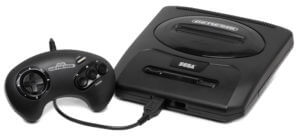
A smaller and cheaper revision to produce, which loses the charm of the original when it comes to design for an older collector like yourself. Same features with a new appearance to face the Snes, a way to maximize profits while appearing innovative and modern. As we have already mentioned, the reduction in size was indeed a factor to be taken into account in Japanese homes, so this model made much more sense in their borders than in ours, where the North American thought of “how much bigger better and more powerful”, was still present in our little heads (miniaturization would soon be imposed as the most “cool”).
Mega CD

Launched in 1991 in Japan with only 2 games (output) and later in the USA (1992) and Europe (1993) at a very high price, due to the technical improvements it presented (more RAM, a Motorola 68000 at 12.5 MHz… .), the Mega CD was a great revolution that introduced the CD format in the 16 bits of SEGA. Unfortunately, its price was too expensive for most of the public and in the case of North America (1992) and Europe (1993), with the hype of 32 bits (3DO) appearing in all the magazines, the young people preferred to allocate their savings patiently to future consoles.
All this, together with its limited color palette, made a good and powerful peripheral, become a commercial failure. Even so, it has a very interesting catalog from a collecting perspective and more than 2 million units were sold. For all nintenderos, the arrival of the Mega CD was a bullet in the chest, the Mega Drive became a super machine with games of more than 600 megabytes…
Mega CD Karaoke
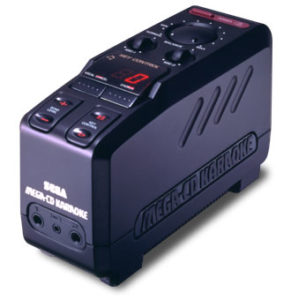
If you had the first Mega Drive, with the Mega CD, friends, you lived in Japan and you were born in a leap year, then you could get hold of this luxurious karaoke… Quite a display of marketing. The rest of the world didn’t even know about it, but the parties that the Japanese had in the 90’s thanks to this little gadget were tremendous.
Mega CD II
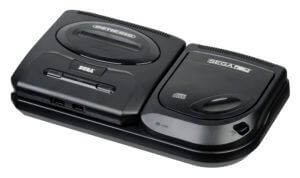
It’s what happens when you have two versions of your main console… Created to be used with the Mega Drive revision. Despite being cheaper, it suffered the same fate as the first model.
32X
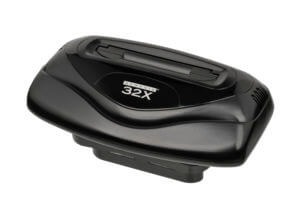
Launched in 1994 and initially conceived as an independent console (a MegaDrive 1.5), Sega America turned it from a system with a better color palette and certain improvements to a complete peripheral that turned our consoles into a complete 32-bit machine. In addition to the Mega CD, they promised compatibility with the Saturn or were silent when asked… It was a lie. For the most part, the public waited to be able to acquire the new 32-bit consoles and the 32X remained an expensive technologically outdated peripheral since its launch, although it is highly valued today by collectors.
This is one of the peripherals/add-ons that have done the most damage to a company. Despite having little success, being discontinued in a very short time to avoid cannibalism with the Saturn, users understood the sale of this device as a hoax and a way to get money out of players, months before the arrival of the 32 bits of SEGA, greatly damaging the image of SEGA. On the eve (or parallel depending on the region) of the launch of its new 32-bit, SEGA shot itself in the foot, losing the trust of thousands of its users.
Mega Jet
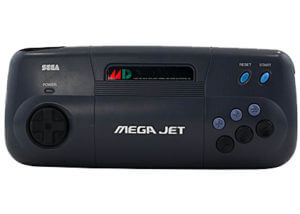
People asked for it, or so they thought of Sega: A portable Mega Drive to play on the plane and incompatible with the Mega CD. Its failure was notorious and only made sense in small Japanese homes… or not even that in 1994, the year of the arrival of the 32-bit reference and Saturn itself.
CDX / Multimega
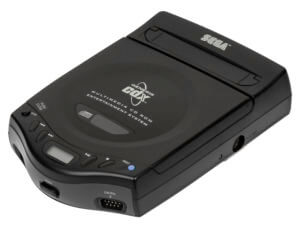
Yes… I know, this is precisely what we needed in 1994, a Discman/MegaDrive/MegaCD… At the gates of the Saturn, PlayStation and the consolidation of 32 bits, Sega released the CDX , one of its most notorious products and that only managed to make the public lose confidence in the brand.
Even so, the technological advance was clear, but far from improving the company’s image, the result was quite the opposite: SEGA was going blind and making its loyal users spend huge amounts of money, and then leaving them lying around. This image does not mean that it was real, but it was the perception of many of the players of the time.
Nomad
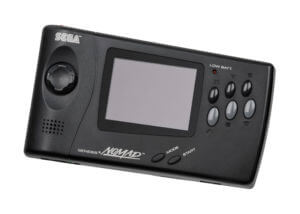
Why not? If we launch a Mega Jet and a CDX, why not launch the Nomad? Sega America threw the house out the window and launched exclusively for the North American market, a huge laptop, without exclusive games and that (they didn’t learn), devoured more batteries than the Game Gear in a few years when batteries were still not cheap. It was a console fiasco in a crazy hardware release strategy.
Wondermega
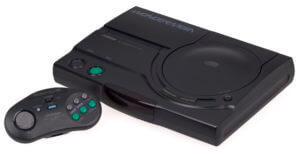
Because Sega hadn’t released enough consoles, it licensed its flagship console and peripheral, the Mega-CD, to JVC (with whom it worked on the Mega CD). Thus, JVC launched the Wondermega, a wonderful console with high quality finishes, compatible with the Mega Drive, Mega CD and with karaoke included. One more proposal to choose from which, unlike many other options, did make sense in small Japanese homes. Two years later they would release a cheaper revision called X’Eye.
TeraDrive
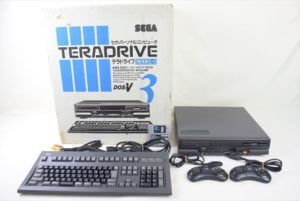
1991, Sega Japan Board of Directors:
– Mr. President, what if we put together a 286 with a MegaDrive and succeed?
– A 286 and a MegaDrive? Hell yeah, hell yeah!
Amstrad Mega PC
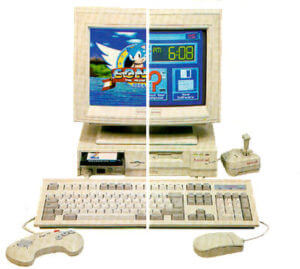
1993, Sega Japan II Board of Directors:
– Mr. President, what if we put together an Amstrad 386 with a MegaDrive and succeed even more?
– An Amstrad 386 and a MegaDrive? Hell yeah!
Sega Pico
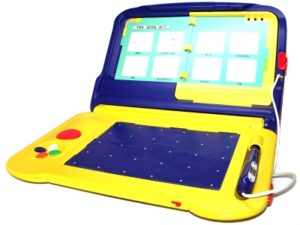
Launched in 1993 in Japan and in 1994 in the rest of the world. The best for last, the Sega Pico: A Mega Drive fused with an electronic book and a tablet, with educational games… Guaranteed success, hey!
My apologies to all those who share Sega’s philosophy for those years, but as history has shown, all the good work that Sega achieved in the early years of the Mega Drive, he threw out the window in his later years (he was 16 bits). It confused its public by launching numerous systems instead of focusing on promoting a single one, offering a whole range of products of different kinds and benefits, at a time when what we users were waiting for was the arrival of 32 bits and their worlds 3D polygons.
On the other hand, it misled them when playing with the ambiguity of whether the Mega CD and 32X would be the same as a Saturn, defrauding all the users who spent a lot of money, hoping that this update of their main system would equate them in advance with the 32-bit era… The general public could see how Sega duped its most staunch followers and then did not meet expectations, with the 32X being the straw that broke the camel’s back. A pity, really.
The Mega Drive, the golden years of Sega
It is true that Sega diversified its main product too much and confused many of its users, but unfortunately, what would come later with the Saturn and the great Dreamcast would be worse… Consequently, we can say that the years of the MegaDrive were the years Sega’s gold standards when it comes to home consoles.
Sega achieved great international prestige and millions of loyal fans, thanks to its console and its good video games. Mascots like Sonic, further strengthened its position as market leader and direct rival of Nintendo, focusing on a profile of players that are more adult or, instead, less childish than Nintendo’s target audience. They knew how to find their market niche and win it hand over hand with a large console that, in practice, was almost the same arcade that we had in the halls.
For all those who were able to enjoy it at the time, the MegaDrive is nostalgia, fun, rebellion, satisfaction, overcoming, vice, colleagues, piques, sleepless nights and squeezed weekends. The MegaDrive is one of the two consoles that marked the 16-bit generation, and that has a lot of merit. Launched the Saturn, Sega turned to its new 32-bit console when it still had a large user base on the MegaDrive, something understandable but that took its toll, a year after the launch of the Saturn, the MegaDrive continued to sell more video games than its older sister, even having a smaller catalog of games, something that the Super Nintendo took advantage of by launching its best video games (since the N64 was years away).
Even so, the MegaDrive endured commercially until 1997, saying goodbye with a Fifa and the wonderful and incredible The Lost World: Jurassic Park of 32 megabytes, one of those games that it seems impossible that they are from a 16-bit machine. The end? No, no, not at all!
Brazil and the MegaDrive
The Brazilian company Tec Toy and Sega have had a fruitful association since the days of the Master System, with Tec Toy having the licenses to distribute Sega consoles from 8-bit to the Dreamcast itself.
As the Brazilian emerging market is one of the most powerful in the entire southern hemisphere, with more than 200 million people, Tec Toy has proven over the years to know its peculiarities perfectly, adapting or publishing its own video games, modifying some consoles and relaunching others, taking into account that a large part of its market are families with very few resources that are looking for accessible entertainment.
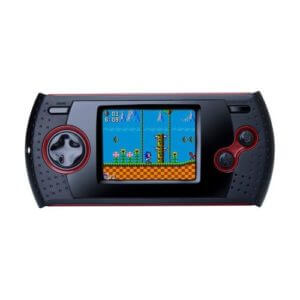
Consequently, Brazil has functioned for decades as a parallel universe in which Sega, with Tec Toy, has reached an 83% market share, offering specific products for different types of customers and extending the commercial life of consoles. of Sega, as well as its online services and others. Brazil belongs to Sega and Sega continues to sell 8 and 16-bit consoles in Brazil… you’re a bit envious, right?
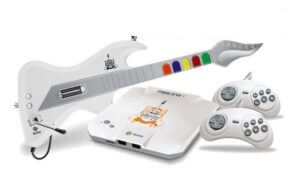
Price of a Mega Drive / Genesis console. How much?
At Infoconsolas we like to show comparisons in order to really understand what it meant to buy a console in its years of commercial life. Let’s see how much MegaDrive and different systems of the time cost in the month of December 1990 in Spain:
- Sega Megadrive con 1 juego: 38.900 Ptas.
- Sega Master System I + 1 juego + 2 mandos: 16.900 Ptas.
- Nintendo Gameboy + Tetris: 18.900 Ptas.
- Nintendo NES SET: 15.990 Ptas.
- Atari Lynx + 1 juego: 17.900 Ptas.
- Amstrad GX4000: 19.900 Ptas.
- Consola Commodore: 19.900 Ptas
- Super Consola C-64: 24.900 Ptas.
- Atari 520 ST: 62.400 Ptas.
- Amiga 500 + monitor: 138.900 Ptas.
- Spectrum +2 + 12 juegos + pistola + joystick: 29.900 Ptas.
As you can see in this case (December 1990), the direct rivals of the Mega Drive in Spain were the 8-bit Master System itself, since they shared many games from its catalog and, if we compared in terms of quality and graphic resources, We already had to look at 16-bit computers like the Atari or Amiga, which had exorbitant prices if our only goal was to play. Consequently, the Mega Drive was very expensive to be a machine just to play, yes, but it is also true that it had just arrived in Europe and they were taking advantage of the fact that they did not have competition in 16 bits, they would have time to lower their price , although if they had done it beforehand they would have captured a large part of the market…
Let us now see how the prices were in Spain in the console world, approximately 2 years later, precisely in July 1992, the year in which the arrival of the Super Nintendo caused a notable drop in prices in both systems:
- Sega Megadrive con 2 mandos + Sonic: 27.900 Ptas.
- Sega Master System II +Alex Kidd: 8.900 Ptas.
- Sega Game Gear + Columns: 18.900 Ptas
- Nintendo SNES + Super Mario World: 29.900 Ptas.
- Nintendo Game Boy + Tetris: 12.900 Ptas.
- Nintendo NES: 9.900 Ptas.
- Neo Geo Aes: 70.000 Ptas.
- NEC Turbografx + Blazing Lazers: 18.900 Ptas.
- Atari Lynx + 1 juego: 17.900 Ptas.
- Atari Lynx II: 17.900
Here yes, Sega put all the meat on the grill and offered a luxury pack at a very good price compared to the Nintendo console, obtaining very good results by having a much higher catalog of games that year. Meanwhile, the NeoGeo was completely on its own and the TurboGrafx begged in the shopping malls for a little love and affection at a reasonable price, a pity that we did not know in those years everything that the system could offer us…
In short, we can see how with the depreciation of the peseta against the dollar or the yen, any ordinary Spaniard would have to make a more than considerable effort to acquire a 16-bit console, so basically every middle-class household could aspire to a single console for an entire generation. Those were other years and the consoles were still intended for a very young audience without purchasing power, to get to have the “Play” and the “Xbox” together in our dining room they had to spend 20 years and spend the money on us, not our parents .
The price of video games on the Mega Drive. How much did a cartridge cost?
The cartridges… damn cartridges full of expensive memories and prodigious chips, how expensive they were to manufacture and how they sneaked us in years later with the supposedly cheap CDs or digital downloads… But hey, let’s focus again. How much did a Mega Drive cartridge cost? Let’s take the year July 1992 as a reference once again and start with the system that still predominated in most of our homes, the ZX Spectrum and its wonderful and cheap tapes:
- Spectrum 128K, Golden Axe: 1.200 Ptas.
- Spectrum 128K, Pang: 1.200 Ptas.
- Spectrum 128K, Shadow Dancer: 1.200 Ptas.
- Spectrum 128K, Capitan Sevilla: 395 Ptas.
- Spectrum 128K, Commando: 595 Ptas.
- Spectrum 128K, Robocop: 595 Ptas.
From 400 to 1,200 Ptas.… This is what long-suffering Spanish parents were used to paying at that time. Now, let’s look at the prices of the MegaDrive in June 1991:
- Afterburner II: 6.990 Ptas.
- Ghouls’n Ghosts: 8.990 Ptas.
- Klaxx: 5.990 Ptas.
- Wonder Boy III: 6.990 Ptas
- Populous: 8.490 Ptas.
- Dick Tracy : 6.990 Ptas.
Yes, quality was paid for, while the Master System II games cost around 5,500 Ptas at launch, the jump to 16 bits increased that amount by 2,000 or 3,000 Ptas. If we compare it with the Spectrum, a computer reference for every parent eighties or nineties, acquiring a MegaDrive game was basically limited to Three Kings and birthdays. But let’s see how much a cartridge cost in the rest of the systems of the time, now including some of its most direct rivals, let’s go back to July 1992:
- Megadrive, Batman: 7.490 Ptas.
- Master System II, Afterburner : 5.990 Ptas.
- Game Gear, Ninja Gaiden : 4.590 Ptas
- SNES, F-ZERO: 7.990 Ptas.
- NES, Metroid: 6.990 Ptas.
- Gameboy, Robocop: 4.900 Ptas.
- NEC Turbografx, R-Type: 6.900 Ptas.
- Atari Lynx, Rampage: 4.900 Ptas.
- NEOGEO AES, Sengoku: 24.300 Ptas.
Ignoring the NEOGEO, a console that, being a luxury console, played in another league, and the NEC Turbografx, which had a derisory market share outside of Japan, we can see how the Megadrive and Snes games cost practically the same, being Sega’s were usually a bit cheaper, which was appreciated. As we have already mentioned, in those years the acquisition of a new cartridge was an event reserved for very specific dates, the price was very high and, after all, we were talking about imported items with the Peseta as a base compared to the dollar or the yen, we had everything to lose.
On the other hand, the high price of the cartridges, in addition to the cost of production and manufacturing, was due to the need to maximize the income in each of the video games, whether they were owned or licensed: While today we users can have for our new consoles an average of 20 titles or more after a while, the Dreamcast had an average of 8 games sold per console and in the case of 16 bits, the average was lower, it being common to have the console with a few games that left exchanging. Consequently, each sale was crucial for companies in the sector, since they did not have as many opportunities as they do now that the video game industry has become consolidated and generalized, with an adult audience with great purchasing power.
Collecting the Sega Mega Drive
If you want to collect the MegaDrive, you are in luck. Sega’s 16-bit is a wonderful console to start in the world of collecting due to the success it had at the time. There are different alternatives but, if you want an original console you can find them really cheap with all their cables and controls. With a box, things go up a bit, but it is possible to buy a MegaDrive in good condition for about 60 or 80 euros (eBay 2021).
Today it is perfectly possible to buy the console at a reasonable price and, little by little, buy the most representative MegaDrive cartridges, since most of them can be found in second-hand stores and flea markets, as they have been widely distributed. in Europe compared to what it had in Japan. This last point means that, just like other consoles, they have a good percentage of their best games in Japanese format and language, something that makes it very difficult to obtain and enjoy them. With the Megadrive you can rest assured, its software is amply adapted to the West. As usual, as your MegaDrive collection progresses, you will need the benefits of the Internet to complete your catalog, but it will not be something immediate.
If what you want is to collect the different systems and versions that came out around the MegaDrive, that’s a very different topic… Nowadays, getting a Mega CD, a 32X or a Sega Nomad at a reasonable price is practically Impossible, their prices are through the roof. If we look towards the LaserActive or CDX… we can already mortgage the house. The demand for these peripherals is very high, while the supply is very limited, which is why astronomical figures are requested.
To end this section, the MegaDrive offers us another option for collectors: As a successful console, there are different Brazilian versions, reissues and its corresponding “mini” version, with a magnificent selection of its best video games. Consequently, the MegaDrive can still be enjoyed as a live console commercially speaking, thanks to the retro trend, giving us a very good option for both nostalgic people and those who want to know a very important part of the history of video games. .. We are talking about Sonic gentlemen!
Buy a Sega Mega Drive / Sega Genesis
As we have already mentioned in the previous point, buying an original MegaDrive is today relatively simple at street level, and much easier through websites such as eBay. For a small price, you will have a piece of the history of video games in your homes.
From Infoconsolas, a website for console collectors and lovers of retro video games, what we recommend and share with you is that you buy the original console, regardless of its version and either out of nostalgia or to discover the system in its original format, the Mega Classic Drive is an economical console with an advantage over the others: The format of its games in plastic boxes means that they are kept in perfect condition compared to those of other consoles and their cardboard boxes, something to be very grateful to the time to go collecting a system.
In the link above, you can see the prices of the Mega Drive updated at the moment, from the very cheap consoles with controller and cables to the unopened packs still sealed. Good luck in your search, be patient and choose your Mega Drive well!
STOP COLLECTOR! If you’ve seen the console listing on eBay, I want to say THANK YOU. Since 2004, the objective of Infoconsolas is to contribute to preserving the history of consoles and video games through our own collection of systems and the hours of work invested in this very website.
Being an eBay partner listing, if you buy a game or console, you will be helping Infoconsolas in the preservation of video game culture, so thank you very much again!
TOP Retro: Best Sega Mega Drive Games
Let’s clarify this from the beginning, the MegaDrive catalog is gigantic, immense, nourished, varied and varied, venturing to make a reduced TOP with the best games, is a task that entails more disappointments than coincidences between the players, we all have our ” favorite games” in memory and the aggrandizement factor of nostalgia, is what coincidentally makes our old games the most replayable today. Consequently, here is a representative selection from the console’s catalogue, playing different genres and years. Many may be missing, but none are left over:
Sonic the Hedgehog
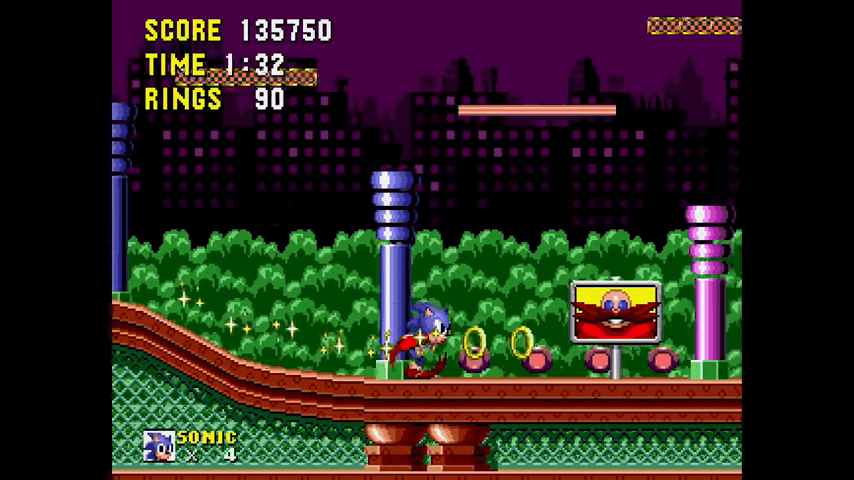
What can we say about Sonic? The game that has been able to rival the almighty Mario. Sega’s hedgehog fell in love with us all and became that image and mascot that Sega needed so much. A true console seller and one of the best games in history in terms of quality/time.
Altered Beast
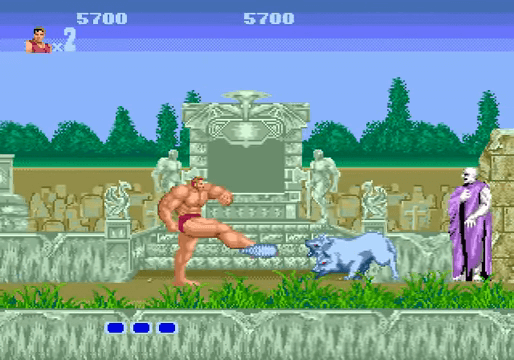
Take a good look at it, because it’s history. Altererd Beast (1988) was so good at the time of its release that it was the game that was included in the original console pack. Altered Beast marked the difference between 8 and 16 bits, between children and adolescents. That said, get hold of it and enjoy the evolution of video games, seeing how it used to be an “essential”.
Ristar the Shooting Star

Ristar (1995) is a video game that elevates the platform concept, turning it into a title at the level of Mario or Sonic, which is not trivial. Ristar endures any comparison, in any of its aspects, with any video game. An authentic great game, an essential of Sega consoles perfectly playable today. Its launch in 1995 shows the ease with which the development teams had, and the high bar that 16 bits already had.
Street Racer
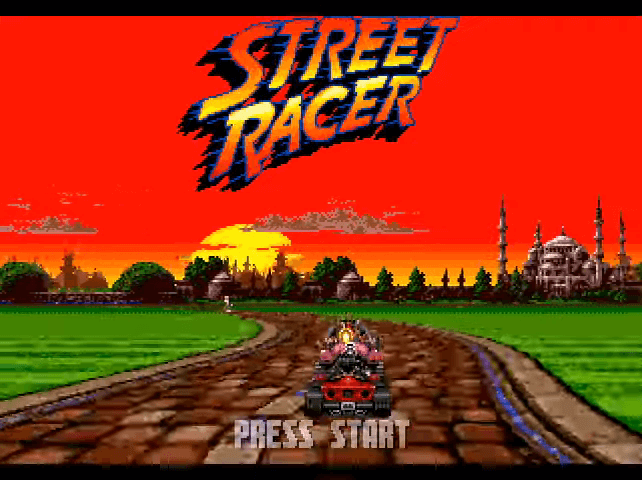
Street Racer (1995 on MegaDrive) was the Vivid Image studio’s response to the well-known Mario Kart. As they didn’t win in popularity, they had to work on a much more “hooligan” game with different game modes and a great multiplayer of up to 4 players on the same console… on a 16-bit!! So that today they cry to us with the frame rate…
Sparkster
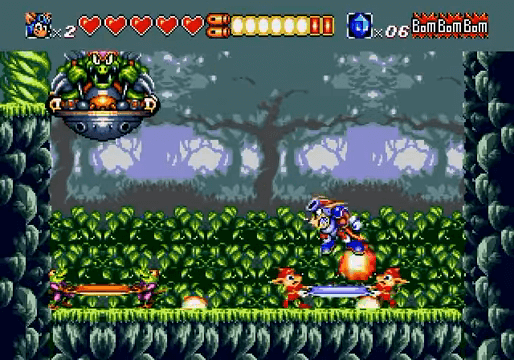
Another one of those late platforms (1994) in which we can see the evolution of the genre and the expertise in making the most of the possibilities of the console. Konami in its good years.
Aladdin
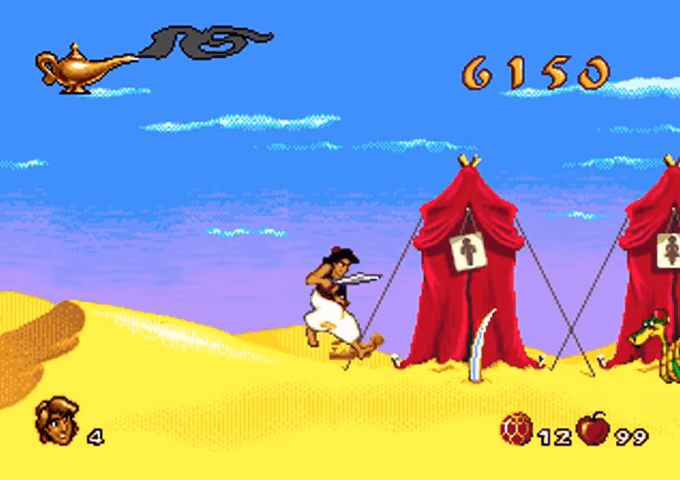
It may seem childish, but in those years Disney was cool, we compared the games with the movies and we freaked out with their movements and animations… In this context, Aladdin proved to be a great game with the eternal comparison of its counterpart on Super Nintendo.
Michael Jackson’s Moonwalker
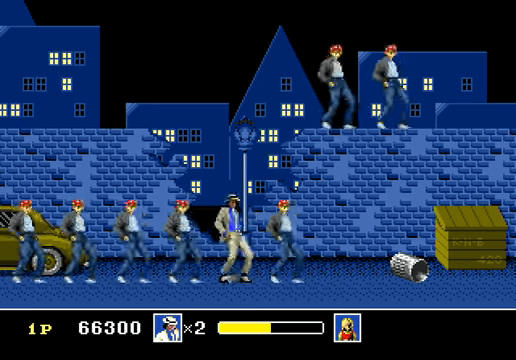
In 1990, Nintendo had the best console developers “picked up” with exclusive contracts, so Sega chose to sign sports and music stars, creating this timeless work of art, not so much for the game itself, but for what it represents.
Castle of Illusion
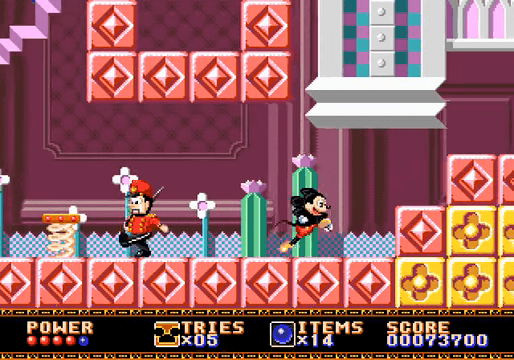
The magic of Disney was rampant in the circuits of our Mega Drive, a perfect combo in a magnificent platform starring the only mascot that could rival the mustachioed Nintendo (in those years). Back in 1990, this was as close as we got to being able to play a Mickey Mouse “movie”, and we were thrilled!
Mortal Kombat
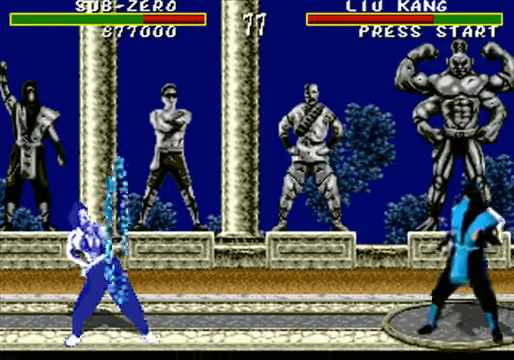
Mortal Kombat was a real console seller, few people give it the importance it deserves: The game that was destined to rival Street Fighter II in arcades, ended up becoming a key player in the 16-bit war. A more adult and reliable version of Sega, without Nintendo’s censorship, ended up marking the line between the target audiences of both brands, in turn starring in one trial or another.
Golden Axe
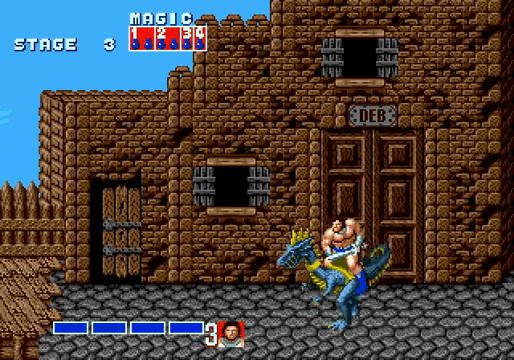
The great, the well-known, the unbeatable Golden Axe. A classic that overflows with nostalgia on all four sides, directly from the arcade, it was like having the arcade at home. Choice of characters, dwarfs, potions, dragons that you could ride… The Mega Drive brought the arcade games to your living room and came out ahead of any comparison.
Quack Shot Starring Donald Duck

Disney and Sega have been one of the most fruitful associations in the history of videogames, the 16-bit Mega Drive gave the graphic artists all the potential they needed to send us jewels like this, torpedoing the waterline of Nintendo and its video games focused on a more childish audience.
Micro Machines
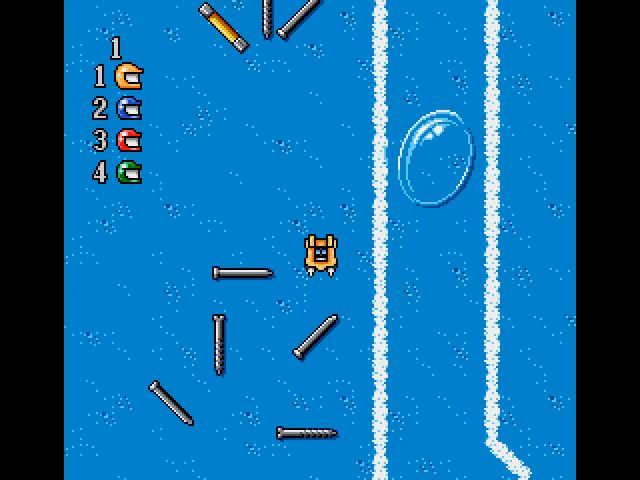
It’s a great game, it’s one of the best there is to play an afternoon with friends today. Two controllers, 4 players, pure fun, pure perfection. Micro Machines is very cool, it may seem like a simplism, but it is the pure reality. If we wash it down with a little beer or a good wine (or other creativity), the gaming experience rises to the top.
Street Fighter II: Special Champion Edition
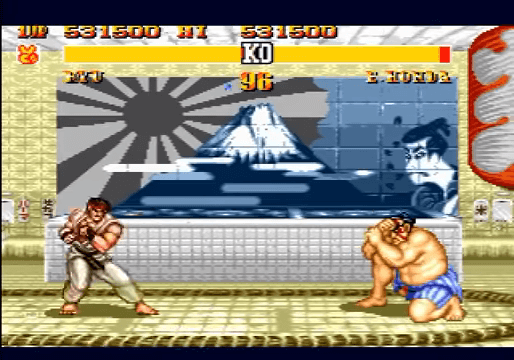
It took a long time to arrive, but it arrived in style. A magnificent conversion of the arcade SFII Champion Edition that served to equalize the fights in class between nintenderos and segueros, with an edition that surpassed the original, starting a particular battle within the Console War in which the Street Fighters were succeeding each other on 16-bit consoles by placing them in first or second place.
Dune: The Battle for Arrakis
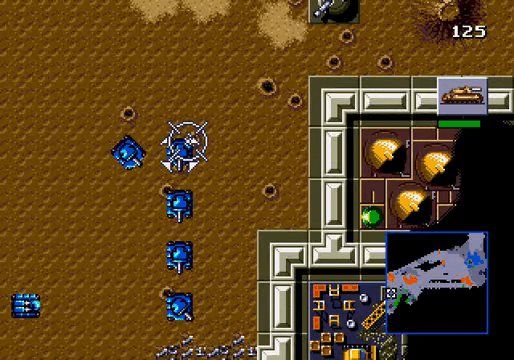
DUNE, one of the first real-time strategy video games beautifully ported to the Sega console. Remarkable mainly for being a little explored genre in those years, and more on consoles. An innovative game that proved to all of us that there was life after platforming.
Landstalker
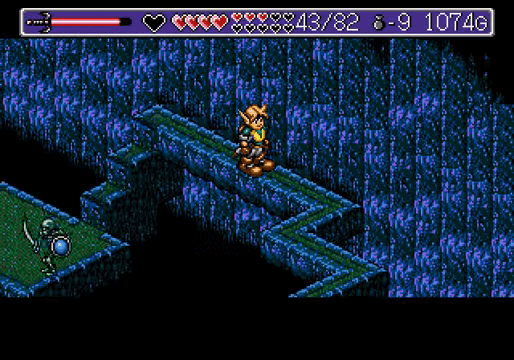
1992, one of the best RPGs on the Sega console, with extensive mapping and isometric perspective, perfectly combines action and exploration. It was one of the most valued games in Japan at the time of acquiring the Mega Drive.
Super Hang-On

A classic, the recreational in your home. MegaDrive could do this and much more, but in 1991 Super Hang-On was what we wanted. Turning on the television and seeing this in your living room was a source of extreme happiness. Pure nostalgia.
Virtua Racing
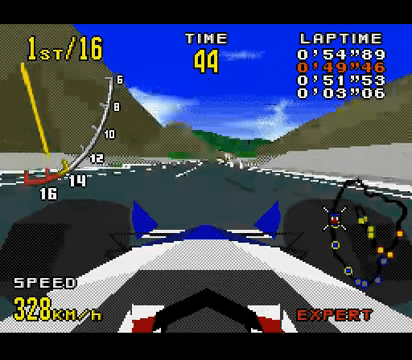
1994, after the arcade that fell in love with the world, the Sega Virtua Processor or SVP chip, made possible a great conversion to the MegaDrive, delighting us with a completely polygonal video game (environments included). A masterpiece and a benchmark in the 16-bit war that looked face to face at Nintendo’s FX Chip.
Shadow Dancer: The Secret of Shinobi
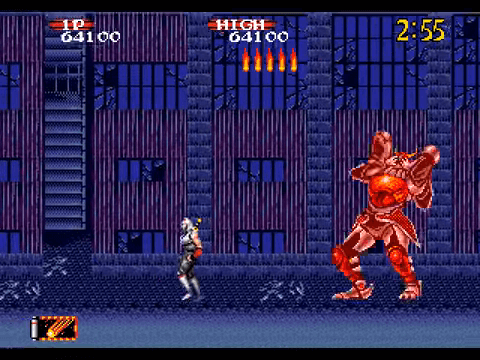
1990, Sega gives us this free version of its arcade, one of the best games in the Shinobi saga, which once again put our beloved Mega Drive on a par with the arcades in our neighborhood and made a difference with the consoles and 8 bit computers of the time..
SEGA MegaDrive FAQ
30 million units worldwide.
October 29, 1988 in Japan / August 14, 1989 in North America / September 1, 1990 in Europe.
1988.
21,000 yen at launch.
On April 23, 1993 in Japan.
12,800 yen at launch.
On December 12, 1992 in Japan.
49,800 yen.
March 10, 1994.
15,000 yen.
On April 24, 1992.
79,800 yen.
4th Generation of video game consoles.
16 bits.
A 16-bit Motorola 68,000 at 7.61 MHz (PAL) or 7.67 MHz (NTSC).
A palette of 512 and 61 on display.
Cartridges.
Crosshead, START and A,B and C.
400 yen.
Approximately 880 worldwide.
Sonic the Hedgehog 2.
Yes, thanks to the Mega Modem.
Super Nintendo.
Sonic the Hedgehog. The well-known blue hedgehog.
Globally, Nintendo’s SNES.
Good very good. In the playable, the 16 bits are up to the task, its graphics preserve the magic of the pixel and physically, the plastic case has preserved them remarkably well.
Yes. Perfectly playable. Unlike the current ones, the difference lies in the greater difficulty and shorter and more intense game sessions.
Technical characteristics of the Mega Drive / Sega Genesis
- CPUs
- Motorola 68000 16-bit at 7.61 MHz (PAL) or 7.67 MHz (NTSC). It is the central processor of the Mega Drive.
- Zilog Z80 8-bit at 3.55 MHz (PAL) or 3.58 MHz (NTSC). This CPU, in the Mega Drive, is used mainly for sound effects tasks, or as the main CPU in Master System compatibility mode, thus allowing the execution of games and cartridges native to it, through a peripheral that provides the corresponding input. , called Power Base Converter, Mega Adapter or Master System Converter depending on the market.
- Memory
- Main RAM: 64KB.
- Video RAM: 64 Kb.
- Sound RAM: 8 Kb.
- ROM: Early Mega Drive models did not, but later models included a 2Kb boot ROM displaying the text “Produced by or under license from Sega Enterprises Ltd.”
- Cartridge capacity: Normally the games were between 4 and 16 Mbits. Some cartridges reached up to 24 Mbits (Jurassic Park, Eternal Champions…). Sonic 3D went up to 32 Mbits and Super Street Fighter II went up to 40 Mbits.
- Graphics
- A VDP processor (Video Display Processor) is in charge of generating and managing the graphics (sprites, scroll planes, etc.).
- Resolution: 320 x 224, 256 x 224, 320 x 240 (only for some games adapted to PAL systems, such as Knuckles’ Chaotix).
- Palette: 512, of which 61 may be chosen to be displayed simultaneously in a typical configuration, unless special modes are applied; there is the Color RAM (or CRAM), which supports a maximum of 4 palettes of 16 colors each, the first color being transparent; you can choose any color as the “background color”, but most games choose one of the transparent colors (hence the common maximum is 61, not 64 or 60). Various games, including Ranger X, Street of Rage III, Sonic 3d Blast, Dynamite Heady, Alien Soldier, Vectorman 1 and 2, Toy Story, Eternal Champions… use 7 bits for color information, so they came to show 128 simultaneous colors or more (the usual in SNES).
- Simultaneous colors on screen: 61 (or more, changing the palette during the sweep and/or activating the shadow-highlight mode).
- Simultaneous sprites on screen: 80/64, 20 maximum per scanline.
- Sound
- Yamaha YM2612 FM 6 channel main sound chip.
- Additional 4-channel sound chip PSG (Programmable Sound Generator) Texas Instruments SN76489.
- Audio 8 bits (interchangeable with an FM channel).
- Entrance exit
- DIN 8 RGB/Audio Mono/Video connector (only on Mega Drive I / Genesis I).
- Mini-DIN 9 RGB/Stereo/Video connector (Mega Drive II / Genesis II).
- RF Modulator (Mega Drive / Genesis I and II).
- Stereo headphones with regulator (Mega Drive I / Genesis I only).
- AUX (DE-9 female connector), present on early Mega Drive / Genesis.
- Joystick with 2 sockets Atari type Sega Mega Drive variant (male DB-9 connector).
- Cartridge slot at the top.
- Expansion bus (Mega Drive / Genesis I and II only), used for the Sega Mega-CD connection.
- Technical characteristics obtained from Wikipedia
External sources and links
- HobbyConsolas magazine
- MicroMania magazine
- Nintendo Acción magazine
- Super Juegos magazine
- Graphic resources and information:
https://segaretro.org/
https://mdshock.com/
https://commons.wikimedia.org/wiki/User:Evan-Amos https://segadoes.com/2016/09/26/the-sega-mega-modem/
https://www.gamegrin.com/directory/platform/commodore-cdtv/about

